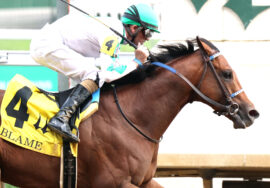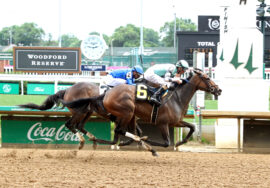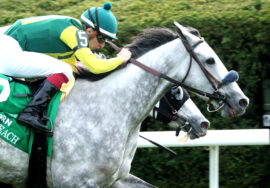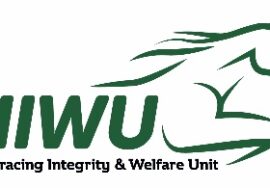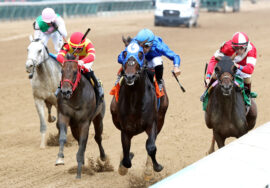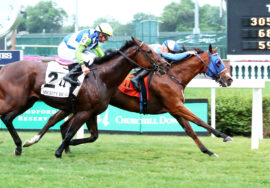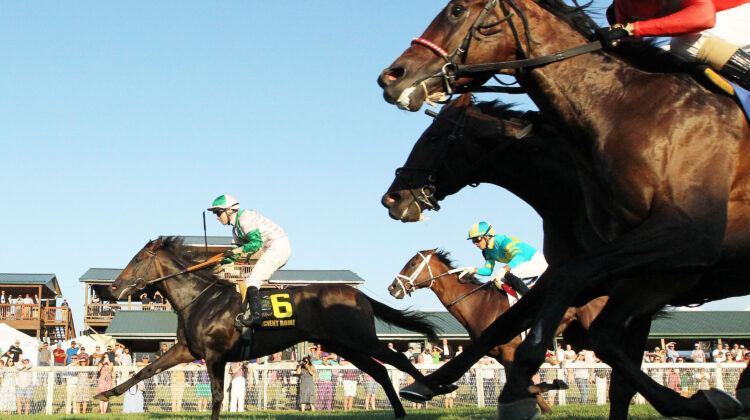
Watching grass grow: Kentucky Downs helps stimulate surge in turf racing
(British invader Ancient Rome winning the $2 million Mint Millions at Kentucky Downs Sept. 2. Coady Photography)
By Mike Kane
FRANKLIN, Ky. (Monday, Sept. 11, 2023) – Grass racing is the whole story at Kentucky Downs. It is a growing story at racetracks across the United States.
In the 33 years since Kentucky Downs opened in 1990 as the Dueling Grounds with a one-day steeplechase meet, Equibase statistics show that through 2022, the number of turf races run in America has grown 42.1 percent. At the same time, the number of dirt races run in the country has decreased by 58.9 percent from 69,142 to 28,384. As a result, turf racing has jumped from 4.8 percent of the races run in 1990 to 14.8 percent in 2022.
During that time period, the Dueling Grounds property, has been developed into Kentucky Downs. The lucrative all-turf meet of seven days, which concludes Wednesday, will have 76 races with more than $24 million in available purse money.
Veteran trainer Rusty Arnold is based in Lexington and has watched turf racing arrive and thrive in the Bluegrass State.
“My first several years training in Kentucky, there was no turf courses at Keeneland or Churchill,” he said. “Then Dueling Grounds come along. The first few years they ran without a starting gate. They (started) with a rope. That’s how far it’s come. You used to have to take them to Arlington or to New York to run on the turf.”
Keeneland ushered in the grass era in Kentucky when it opened its new turf course in 1985. Churchill’s first turf races were run in 1987. Dueling Grounds was next. Ellis Park began offering turf racing in 1993.
Mike Maker, the seven-time meet-leading trainer at Kentucky Downs, has built a solid career handling turf horses. Last year, 589 of his 1,214 starters were on turf, 48.5 percent. His turf runners earned $8.4 million in purses, fourth-highest among the nation’s trainers. Maker grew up in Michigan, where there was no turf racing, and began his career working for his father. He was an assistant for D. Wayne Lukas, who handles more dirt horses, before going out on his own 20 years ago. He is well-known for his ability with turf runners and said that has brought him some clients interested in grass racing.
“Three Diamonds buys a lot of turf horses,” he said. “When I was training for (Ken) Ramsey, with (Ramsey’s stallion) Kitten’s Joy there were a lot of turf horses. It just kind of worked out that way. Had to play the cards we were dealt.”
Those cards have proved quite profitable. Maker said that Kentucky Downs, with its massive purse structure, has had an impact on the growth of turf racing in the country.
“Definitely,” he said. “I always say it’s 10 to 15 percent of my business for the year.”
Hall of fame trainer Shug McGaughey has changed his approach through the years and is far more active on the grass than he was earlier in his career. In 2000, only 25 percent of his starts were on turf. Last year, that number had grown to 57 percent — reflecting 60 percent of his wins and 55 percent of his purse earnings.
McGaughey said he simply is getting more horses with grass pedigrees — and he’s glad for it. This meet he has won two of 18 starts with five seconds and four thirds. But his horses have run out $1,212,521, fourth-highest in the standings, including the $1 million Gun Runner with Talk of the Nation.
The Breeders’ Cup started out in 1984 with just two turf races out of its seven championship races. When Churchill Downs hosted the 2000 Breeders’ Cup, there were eight races, three on turf. Fast forward to 2018 and half of the 14 Breeders’ Cup races were on grass – which remains the lineup.
Florida-based trainer Saffie Joseph Jr. grew up in Barbados, which does not have dirt racing. His turf background has been useful as he has built his U.S. business in the last decade.
“Generally you can find a turf horse at a cheaper price than a true dirt horse,” he said. “And there are so many turf opportunities, just as Kentucky Downs shows. You don’t mind buying a turf horse, for sure, because there is a lot more appeal now because of the purses available.”
So far this season, nearly a third of Joseph’s starts have been on the grass.
“For a turf horse, there is a lot of money to be made,” he said.
Kentucky Downs also has helped launch some notable dirt horses. Breeders’ Cup Classic winner Fort Larned, Breeders’ Cup Distaff winner One Dreamer, Grade 1 winners Art Collector and Angel of Empire all ran at Kentucky Downs before going on to fame on dirt. Most recently, Red Route One won his debut at Kentucky Downs last year and went on to win this year’s West Virginia Derby (G3) and finish fourth in the Preakness Stakes.




